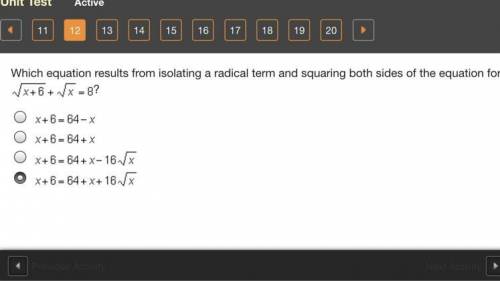
Mathematics, 22.04.2021 23:00 nicoleaaliyah
Which of the following describes the solution to the equation
– 5 is an extraneous solution, and 1 is a true solution.
– 5 is a true solution, and 1 is an extraneous solution.
Both –5 and 1 are true solutions.
Both –5 and 1 are extraneous solutions. Not sure if I did it right


Answers: 2


Other questions on the subject: Mathematics

Mathematics, 21.06.2019 14:00, romaguera06
Blank × 10-3 is 2,000 times greater than 1.9 × 10-6. it is also blank times greater than 9.5 × 10-4.
Answers: 2

Mathematics, 21.06.2019 16:30, cxttiemsp021
Which approach to the theory-and-research cycle does the following sequence reflect: (1) specific observations suggest generalizations, (2) generalizations produce a tentative theory, (3) the theory is tested through the formation of hypotheses, and (4) hypotheses may provide suggestions for additional observations?
Answers: 1

Mathematics, 21.06.2019 17:00, SillyEve
In tossing one coin 10 times, what are your chances for tossing a head? a tail? 2. in tossing one coin 100 times, what are your chances for tossing a head? a tail? 3. in tossing one coin 200 times, what are your chances for tossing a head? a tail? deviation = ((absolute value of the difference between expected heads and observed heads) + (absolute value of the difference between expected tails and observed tails)) divided by total number of tosses. this value should always be positive. 4. what is the deviation for 10 tosses? 5. what is the deviation for the 100 tosses? 6. what is the deviation for 200 tosses? 7. how does increasing the total number of coin tosses from 10 to 100 affect the deviation? 8. how does increasing the total number of tosses from 100 to 200 affect the deviation? 9. what two important probability principles were established in this exercise? 10. the percent of occurrence is the obtained results divided by the total tosses and multiplied by 100%. toss the coins 100 times and record your results. calculate the percent occurrence for each combination. percent head-head occurrence: percent tail-tail occurrence: percent head-tail occurrence:
Answers: 3

Mathematics, 21.06.2019 17:20, maricruzisfye
Which of the following pairs of functions are inverses of each other? o a. f(x)=x72+8 and 96-9 = 7/x+2) =8 o b. f(x)= 6(x - 2)+3 and g(x) - *#2-3 o c. $4) = 5(2)-3 and 90- 4*: 73 o d. f(x) = 6)-12 and 910 – +12
Answers: 1
You know the right answer?
Which of the following describes the solution to the equation
– 5 is an extraneous solution, and 1...
Questions in other subjects:

Mathematics, 20.06.2020 00:57




English, 20.06.2020 00:57







